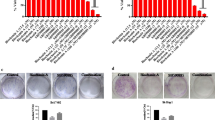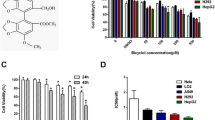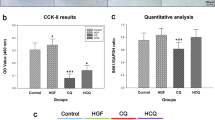Abstract
Background
Human hepatocellular carcinoma (HCC) is highly ubiquitinated. The ubiquitination is important to the generatation of HCC. The antitumor and antifibrosis effects of an ubiquitin–proteasome system inhibitor, bortezomib, on HCC with liver cirrhosis (LC) were analyzed in vitro and in vivo.
Methods
The effect of bortezomib was analyzed in the rat hepatocarcinogenesis model using a DEN and CDAA diet (DEN/CDAA model), which shows severe LC and generation of HCC. The decrease of GST-P-positive foci and HCC were analyzed in vivo. Cell death was analyzed by cell death detection kit. Liver fibrosis was checked by sirius-red staining and α-smooth muscle actin staining. The in vitro study involved 3 HCC cell lines (HepG2, HuH7, and HLF) and primary rat and human hepatocytes. The proliferation rate of the HCC cell line was analyzed using the MTT assay and FACS analysis. The toxicity of bortezomib was checked using the LDH release assay for primary human and rat hepatocytes.
Results
In the rat hepatocarcinogenesis model, bortezomib prevented the development of preneoplastic lesions during the early stages of hepatocarcinogenesis and specifically induced cell death in HCC. Furthermore, bortezomib inhibited cell proliferation and induced tumor-specific cell death in HCC cell lines with decrease of cyclin D1 and phospho-Rb expression. Further, bortezomib showed no hepatotoxicity of primary rat and human hepatocytes, suggesting that it might be an HCC-specific drug. Bortezomib also prevented the activation of hepatic stellate cells and inhibited the liver fibrosis of the DEN/CDAA model.
Conclusions
Bortezomib appears to be an ideal target drug for HCC with LC.







Similar content being viewed by others
References
Kamangar F, Dores G, Anderson W. Patterns of cancer incidence, mortality, and prevalence across five continents: defining priorities to reduce cancer disparities in different geographic regions of the world. J Clin Oncol. 2006;24:2137–50.
Parkin D, Bray F, Ferlay J, Pisani P. Global cancer statistics, 2002. CA Cancer J Clin. 2005;55:74–108.
El-Serag H, Marrero J, Rudolph L, Reddy K. Diagnosis and treatment of hepatocellular carcinoma. Gastroenterology. 2008;134:1752–63.
Sakaida I, Hironaka K, Uchida K, Suzuki C, Kayano K, Okita K. Fibrosis accelerates the development of enzyme-altered lesions in the rat liver. Hepatology. 1998;28:1247–52.
Ebara M, Okabe S, Kita K, Sugiura N, Fukuda H, Yoshikawa M, et al. Percutaneous ethanol injection for small hepatocellular carcinoma: therapeutic efficacy based on 20-year observation. J Hepatol. 2005;43:458–64.
Matsui O, Kadoya M, Yoshikawa J, Gabata T, Arai K, Demachi H, et al. Small hepatocellular carcinoma: treatment with subsegmental transcatheter arterial embolization. Radiology. 1993;188:79–83.
Yamasaki T, Kurokawa F, Shirahashi H, Kusano N, Hironaka K, Okita K. Percutaneous radiofrequency ablation therapy with combined angiography and computed tomography assistance for patients with hepatocellular carcinoma. Cancer. 2001;91:1342–8.
Todo S, Furukawa H. Living donor liver transplantation for adult patients with hepatocellular carcinoma: experience in Japan. Ann Surg. 2004;240:451–9 (discussion 459–61).
Llovet J, Ricci S, Mazzaferro V, Hilgard P, Gane E, Blanc J, et al. Sorafenib in advanced hepatocellular carcinoma. N Engl J Med. 2008;359:378–90.
Kogure T, Iwasaki T, Ueno Y, Kanno N, Fukushima K, Yamagiwa Y, et al. Complete remission of a case of hepatocellular carcinoma with tumor invasion in inferior vena cava and with pulmonary metastasis successfully treated with repeated arterial infusion chemotherapy. Hepatogastroenterology. 2007;54:2113–6.
Nakamura M, Nagano H, Wada H, Noda T, Ota H, Damdinsuren B, et al. A case of hepatocellular carcinoma with multiple lung, spleen, and remnant liver metastasis successfully treated by combination chemotherapy with the novel oral DPD-inhibiting chemotherapeutic drug S-1 and interferon-alpha. J Gastroenterol. 2006;41:1120–5.
Shirahashi H, Sakaida I, Terai S, Hironaka K, Kusano N, Okita K. Ubiquitin is a possible new predictive marker for the recurrence of human hepatocellular carcinoma. Liver. 2002;22:413–8.
Chen K, Yu H, Liu T, Lee S, Chen P, Cheng A. Synergistic interactions between sorafenib and bortezomib in hepatocellular carcinoma involve PP2A-dependent Akt inactivation. J Hepatol. 2010;52:88–95.
Kim GP, Mahoney MR, Szydlo D, Mok TS, Marshke R, Holen K, et al. An international, multicenter phase II trial of bortezomib in patients with hepatocellular carcinoma. Invest New Drugs. 2012;30:387–94.
Anan A, Baskin-Bey ES, Bronk SF, Werneburg NW, Shah VH, Gores GJ. Proteasome inhibition induces hepatic stellate cell apoptosis. Hepatology. 2006;43:335–44.
Yamamoto N, Wu J, Zhang Y, Catana A, Cai H, Strom S, et al. An optimal culture condition maintains human hepatocyte phenotype after long-term culture. Hepatol Res. 2006;35:169–77.
Lappalainen K, Jääskeläinen I, Syrjänen K, Urtti A, Syrjänen S. Comparison of cell proliferation and toxicity assays using two cationic liposomes. Pharm Res. 1994;11:1127–31.
Takami T, Terai S, Yokoyama Y, Tanimoto H, Tajima K, Uchida K, et al. Human homologue of maid is a useful marker protein in hepatocarcinogenesis. Gastroenterology. 2005;128:1369–80.
Kawaguchi K, Sakaida I, Tsuchiya M, Omori K, Takami T, Okita K. Pioglitazone prevents hepatic steatosis, fibrosis, and enzyme-altered lesions in rat liver cirrhosis induced by a choline-deficient L-amino acid-defined diet. Biochem Biophys Res Commun. 2004;315:187–95.
Adams J, Palombella VJ, Sausville EA, Johnson J, Destree A, Lazarus DD, et al. Proteasome inhibitors: a novel class of potent and effective antitumor agents. Cancer Res. 1999;59:2615–22.
Calvaruso G, Giuliano M, Portanova P, De Blasio A, Vento R, Tesoriere G. Bortezomib induces in HepG2 cells IkappaBalpha degradation mediated by caspase-8. Mol Cell Biochem. 2006;287:13–9.
Hideshima T, Richardson P, Chauhan D, Palombella VJ, Elliott PJ, Adams J, et al. The proteasome inhibitor PS-341 inhibits growth, induces apoptosis, and overcomes drug resistance in human multiple myeloma cells. Cancer Res. 2001;61:3071–6.
Acknowledgments
This study was supported by Grants-in-Aid for Scientific Research from the Japan Society for the Promotion of Science (21659189 and 22390150), the Japan Science and Technology Agency, and the Ministry of Health, Labour and Welfare.
Conflict of interest
The authors declare that they have no conflict of interest.
Author information
Authors and Affiliations
Corresponding author
Rights and permissions
About this article
Cite this article
Saeki, I., Terai, S., Fujisawa, K. et al. Bortezomib induces tumor-specific cell death and growth inhibition in hepatocellular carcinoma and improves liver fibrosis. J Gastroenterol 48, 738–750 (2013). https://doi.org/10.1007/s00535-012-0675-z
Received:
Accepted:
Published:
Issue Date:
DOI: https://doi.org/10.1007/s00535-012-0675-z




